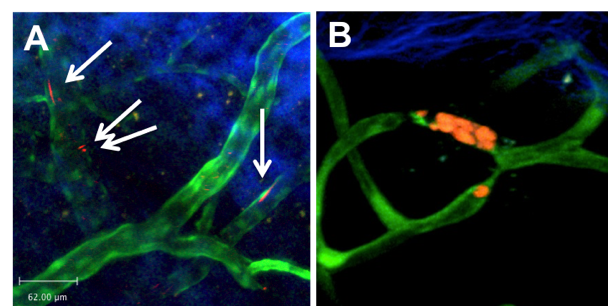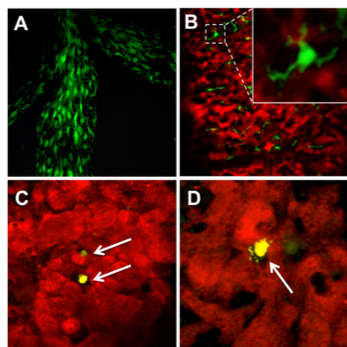Research of Infectious Diseases, Host-Pathogen Interactions and Immunology
The Konradt lab studies infections and the subsequent host immune response in two separate, yet overlapping compartments: the vascular system and the placenta.
Research Focus 1: The role of EC in the immune response
There are more than 10 trillion EC in the human body, that cover 4000 m2, and these are an important replicative niche for a subset of micro-organisms such as Dengue virus, West Nile Virus, CMV, S. aureus and T. gondii. For many micro-organisms the ability to infect EC is a key part of their pathogenesis. Indeed, EC express TLR and influence coagulation and neutrophil recruitment and their activation can lead to vascular damage, while expression of adhesion molecules promotes extravasation of inflammatory cells. Numerous in vitro studies have demonstrated that EC can be activated by cytokines to limit viral,  bacterial and parasite replication. Furthermore, evidence that EC interact with the adaptive response is implicit in the ability of EC to present MHC class I & II restricted antigens. However, whether EC antigen presentation via MHC-I or MHC-II has a tolerogenic or inflammatory role during infection remains unclear. Therefore, there is a major knowledge gap in our understanding in the involvement of EC in orchestrating a T cell response or how the immune system reacts to infected EC in vivo.
bacterial and parasite replication. Furthermore, evidence that EC interact with the adaptive response is implicit in the ability of EC to present MHC class I & II restricted antigens. However, whether EC antigen presentation via MHC-I or MHC-II has a tolerogenic or inflammatory role during infection remains unclear. Therefore, there is a major knowledge gap in our understanding in the involvement of EC in orchestrating a T cell response or how the immune system reacts to infected EC in vivo.
Figure 1. A: Free T. gondii (Red) can be detected in the vascular compartment after infection of a Tie2-GFP reporter mouse. B: T. gondii (Red) invades and replicates in endothelial cells (Green).
Research Focus 2: Immune responses at the Maternal-Fetal Interface
The maternal-fetal interface is the interface between the uterine mucosa and the extraembryonic tissues of the developing conceptus. The placenta functions as the primary nutrient and gas exchange organ of the fetus by diverting maternal blood flow from the uterus. Once inside the placenta, maternal blood exchanges nutrients, gases, and metabolic waste products with fetal blood coursing through a physically separate vasculature that connects to the fetus via the umbilical cord. A successful pregnancy involves complex  interactions between fetal trophoblasts, endothelial cells and maternal decidual immune cells, creating an immunologically unique site that allows the tolerance to the allogenic fetus but still maintains host defense against possible pathogens. Infections are a well-described cause for fetal losses and stillbirths, as well as for perinatal morbidity. Indeed, infections are accounted for up to 15% of early miscarriages and up to 66% of late miscarriages. Moreover, infections can further lead to preterm birth or infants with birth defects leading to lifelong disabilities. This is accompanied with significant health care costs and a burden for the mothers mental health and psychological wellbeing. Immune responses at the maternal-fetal interface during infection are poorly understood and there is a real need for a better understanding of the immunological mechanisms at this site.
interactions between fetal trophoblasts, endothelial cells and maternal decidual immune cells, creating an immunologically unique site that allows the tolerance to the allogenic fetus but still maintains host defense against possible pathogens. Infections are a well-described cause for fetal losses and stillbirths, as well as for perinatal morbidity. Indeed, infections are accounted for up to 15% of early miscarriages and up to 66% of late miscarriages. Moreover, infections can further lead to preterm birth or infants with birth defects leading to lifelong disabilities. This is accompanied with significant health care costs and a burden for the mothers mental health and psychological wellbeing. Immune responses at the maternal-fetal interface during infection are poorly understood and there is a real need for a better understanding of the immunological mechanisms at this site.
Figure 2. 2-photon images of a mouse placenta: A: Endothelial cells (Green) in the chorionic plate. B: Labyrinth zone with maternal blood (Red) and fetal macrophages (Green). C/D: T. gondii (Yellow) localized in the labyrinth zone in vivo. Replicating Parasites (white arrows) with maternal blood (Red).

 By using our website you agree to our
By using our website you agree to our